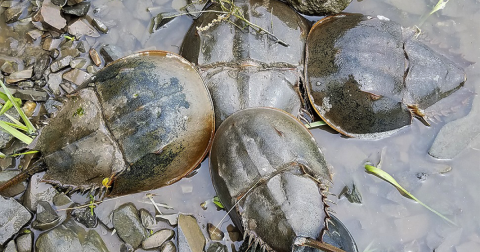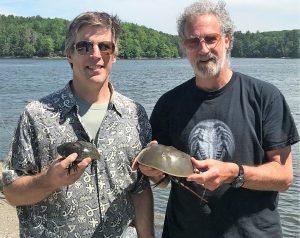
Researchers at Plymouth State University (PSU) have found the process used to extract blood from horseshoe crabs, known as ‘biomedical bleeding,’ triggers a decrease in the oxygen-carrying protein hemocyanin. Lowered hemocyanin levels could cause death or reduced activity and mating, possibly leading to a smaller population of this keystone species. Horseshoe crab blood is unique and used by scientists to test devices and injectable drugs for bacterial contamination, creating a large market for this valuable resource. The research team, Chris Chabot, Ph.D., PSU professor of biology, and Meghan Owings. M.S., and Winsor Watson III, Ph.D., from the University of New Hampshire (UNH), hopes these findings will inform new best practices for the biomedical bleeding industry, which will play a vital role in ensuring COVID-19 vaccines in development are contaminant-free.

Chris Chabot, Ph.D., PSU professor of biology, and Winsor Watson III, Ph.D., from the University of New Hampshire
“Horseshoe crabs play significant roles in our environment and in medical research, especially now as the scientific community works towards an effective COVID-19 vaccine,” said Chabot. “But it is critical that their role in medical research does not disrupt their natural role as a keystone species. Our research provides key insights about biomedical bleeding’s impact on horseshoe crab behavior and health, which we hope will influence harvesting practices to ensure the wellbeing and survival of the population and the ecosystems in which they live.”
Chabot first joined the faculty at PSU in 1992 and has been studying horseshoe crabs for nearly 20 years. He serves as a member of the editorial board for the Journal of Circadian Rhythms. Over the years, Chabot has secured nearly $2 million in grant funding to support his research, which has been published 35 times.
The biomedical bleeding process exposes horseshoe crabs to several stressors; they spend a significant time out of water, they are exposed to much warmer temperatures, and they lose up to 30 percent of their blood volume. For this study, the PSU and UNH research team collected 48 male horseshoe crabs in 2016 and 63 female horseshoe crabs in 2017 at Fox Point in the Great Bay Estuary in Durham, New Hampshire. Throughout the study, researchers exposed a subset of the horseshoe crabs to all three stressors caused by the biomedical bleeding process (air exposure, heat and bleeding). Other subsets of horseshoe crabs were only exposed to one or a combination of two stressors; a separate subset served as the control. The horseshoe crabs were monitored for two weeks in the lab after two days of exposure.
Based on the data, Chabot and the research team concluded the full bleeding treatment (air exposure, heat and bleeding) had the largest effect on mortality and hemocyanin levels. Although horseshoe crabs can rapidly regain most of their blood volume, it takes much longer for them to replace lost hemocyanin. Lower hemocyanin levels impair the animals’ ability to obtain and circulate sufficient oxygen, potentially leading to reduced activity or death. The team analyzed the data and determined horseshoe crabs with a baseline level less than 13 milligrams per milliliter (mg/mL) were the most likely to die or to be impaired by the bleeding process. Of the horseshoe crabs that died, most did so within two days of exposure.
The team also learned hemocyanin levels tend to decrease while horseshoe crabs are held in captivity. Additionally, horseshoe crabs’ hemocyanin levels are lowest in May and June and highest in August and September. Females were also found to have lower hemocyanin levels, which could be due to the energy needed to produce eggs and to make several trips to spawning beaches; therefore female horseshoe crabs are more negatively impacted by the biomedical bleeding process than males.
The research team used the data to develop several recommendations for biomedical bleeding facilities to help ensure the safety and survival of horseshoe crabs:
- Organizations should return horseshoe crabs to their natural environments as soon as possible.
- Teams should be mindful of timing, harvesting female horseshoe crabs in months when their hemocyanin levels are highest, aiming to make the bleeding process less detrimental to their health.
- Biomedical bleeding facilities should take blood samples before bleeding and only proceed with bleeding the animals that have healthy hemocyanin levels (higher than 13 mg/mL).
- Facilities should use high-quality water and frequent feeding to maintain the animals’ health before and after bleeding.
This research was recently published in Fishery Bulletin, a quarterly peer-reviewed scientific journal published by the National Oceanic and Atmospheric Administration (NOAA).

